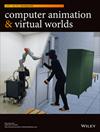将基于网络的虚拟现实课堂体验添加到混合课程模式中
IF 1.7
4区 计算机科学
Q4 COMPUTER SCIENCE, SOFTWARE ENGINEERING
引用次数: 0
摘要
混合式教室是面对面(F2F)互动和在线学习的独特空间。混合课堂有三种不同的互动类型:面对面同步、虚拟同步和虚拟异步;每一种形式都适用于不同形式的扩展现实。本案例研究着眼于在一所大学的三个高年级或高级(初级和高级)高等教育设计课程中使用虚拟现实(VR)教室进行在线同步每周会议。在课堂上使用社交网络VR可以提供一个协作的、实时的环境,弥合了虚拟视频会议和游戏平台之间的差距。本文探讨了如何在虚拟课堂中使用社交网络VR。在学期调查结束时,使用混合方法收集可用性数据。系统可用性量表(SUS)和几个定性问题收集了学生的反馈。总体而言,学生们喜欢使用VR教室,但音频问题似乎是最重要的痛点。虽然总体反应是积极的,但本研究将从学生和教师的角度解决几个需要改进的领域。社交的、基于网络的VR提供了巨大的潜力。设计一个以人为中心的虚拟环境,并考虑所有参与者的总体用户体验,对于一个成功的学习工具至关重要。本文章由计算机程序翻译,如有差异,请以英文原文为准。
Adding a Web-Based Virtual Reality Classroom Experience to a Hybrid, Blended Course Modality
The blended classroom is a unique space for face-to-face (F2F) interaction and online learning. The blended classroom has three distinct interaction types: in-person synchronous, virtual synchronous, and virtual asynchronous; each of these modalities lends itself to different forms of extended reality. This case study looks at using a virtual reality (VR) classroom for an online synchronous weekly meetings for three upper-division or advanced (junior and senior level) higher education design classes at a university. The use of social web VR for a classroom can offer a collaborative, real-time environment that bridges the gap between virtual video conferences and gaming platforms. This paper examines how to use social web VR in a virtual classroom. Mixed methods were used to collect usability data at the end of the semester survey. The system usability scale (SUS) and several qualitative questions gathered student feedback. Overall, the students enjoyed using the VR classroom, but audio issues seemed to be the most significant pain point. While the overall response was positive, this study will address several areas for improvement from both the student and instructor perspectives. Social, web-based VR offers promising potential. Designing a human-centered virtual environment and considering all participants’ total user experience is critical to a successful learning tool.
求助全文
通过发布文献求助,成功后即可免费获取论文全文。
去求助
来源期刊

Computer Animation and Virtual Worlds
工程技术-计算机:软件工程
CiteScore
2.20
自引率
0.00%
发文量
90
审稿时长
6-12 weeks
期刊介绍:
With the advent of very powerful PCs and high-end graphics cards, there has been an incredible development in Virtual Worlds, real-time computer animation and simulation, games. But at the same time, new and cheaper Virtual Reality devices have appeared allowing an interaction with these real-time Virtual Worlds and even with real worlds through Augmented Reality. Three-dimensional characters, especially Virtual Humans are now of an exceptional quality, which allows to use them in the movie industry. But this is only a beginning, as with the development of Artificial Intelligence and Agent technology, these characters will become more and more autonomous and even intelligent. They will inhabit the Virtual Worlds in a Virtual Life together with animals and plants.
 求助内容:
求助内容: 应助结果提醒方式:
应助结果提醒方式:


